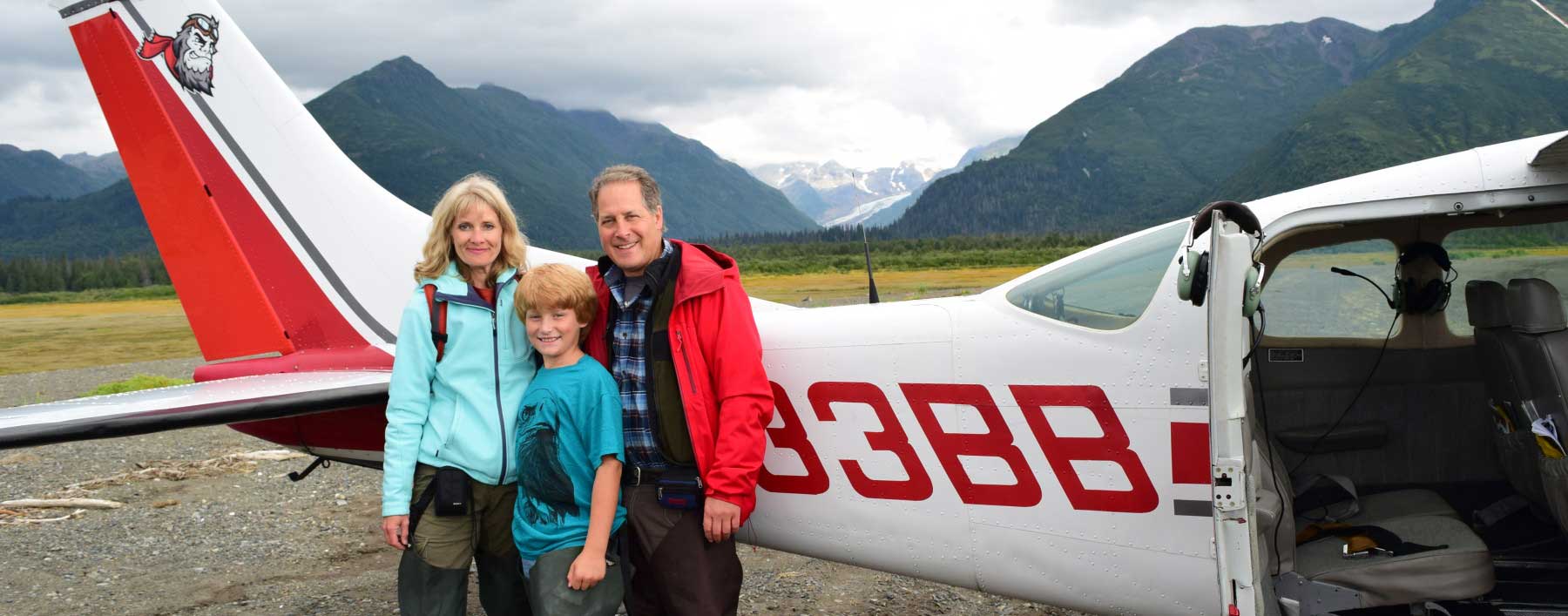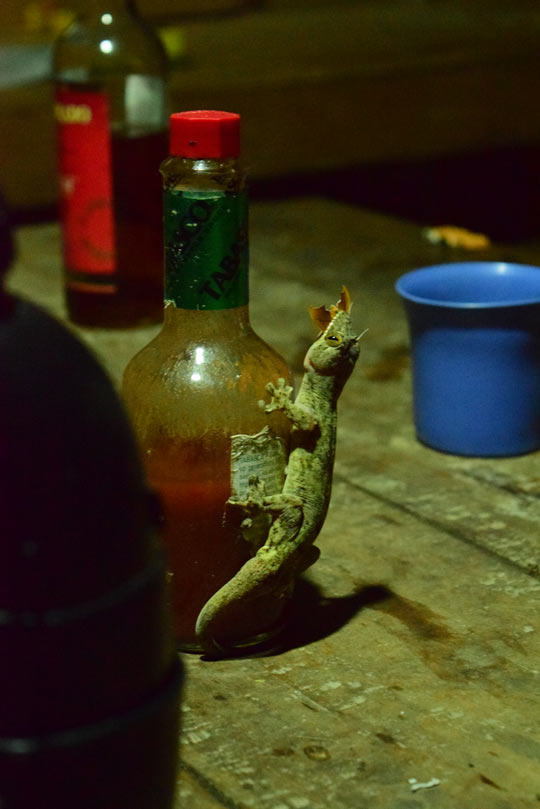I had checked my fire last night and put some more wood on so the boots would dry a bit more as I was sleeping. As soon as it’s light out, I take the boots and the Christmas tree stick I made a few days ago and set it up in the clearing by the bow targets.
Once the sun is up above the trees, the clearing gets searing hot. My stick works perfectly to hold and prop open the boots. When I get them later, they are almost dry, and with a new dry pair of insoles (yes, that was part of my pre-planning in case the boots got wet, score one for the planner!), my feet feel fine. – After bow hunting, I take them off again and set them in the sun during our morning lecture. After that, they feel totally dry. Whoohoo! Foot rot averted, LOL!
Bow hunting today is with a smaller target (soap bottle set in front of the boogie boards). I am doing much better than on the first day, or even yesterday. I am now able to get my arrows into the boogie board at least most of the time, unless I experiment with a new parameter (pull back more for more power? Aim above the target to hit it on the downslope? Shoot from the shadow side of the barn vs the sun side?) – any time I try anything new, I suck until I find my groove again. 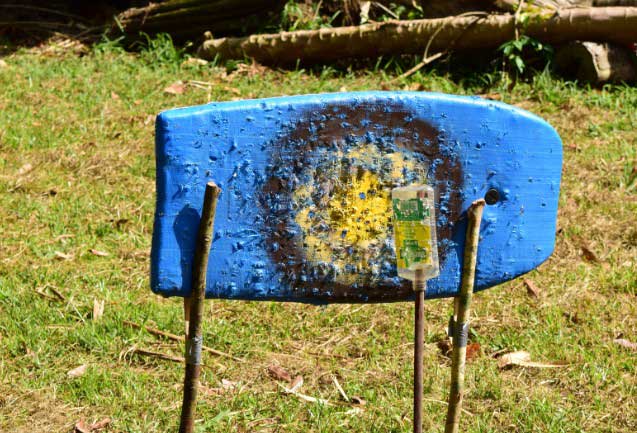 Today, I hit the bottle a few times, but the arrows glance off. Much better, but still, it is painfully clear to me that if I have to hunt to support myself, I’ll be doing an extended fast.
Today, I hit the bottle a few times, but the arrows glance off. Much better, but still, it is painfully clear to me that if I have to hunt to support myself, I’ll be doing an extended fast.
After bow hunting, Ian gives us a lecture on “nasties of the jungle:” snakes, scorpions, big hairy caterpillars, tarantulas, bullet ants, killer bees, big cats and caimans, and various other venomous and otherwise dangerous animals.
Fun fact: jaguars always attack from behind and they kill by crushing your skull with their powerful teeth. With one bite, they can take down a caiman. He takes this opportunity to point out that Lionel found jaguar tracks in the mud (since the rain the day before) about 300 yards from camp. Dang! That’s pretty close. 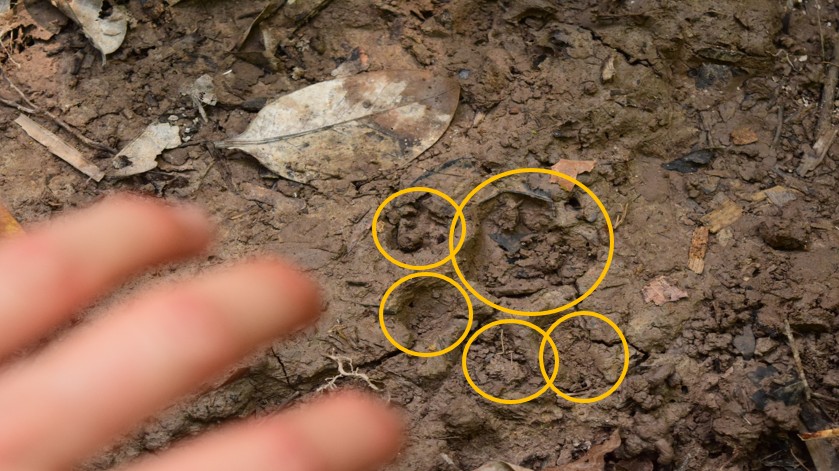 But, he says, none of the animals are out to get us. We are not part of their eco system. They don’t know what we are. We are not prey. We are not a danger to them that they need to defend against.
But, he says, none of the animals are out to get us. We are not part of their eco system. They don’t know what we are. We are not prey. We are not a danger to them that they need to defend against.
Basically, the animals don’t care about us. We don’t exist for them. So they’re there, but they are not a danger to us. “The greatest danger to you out here, is YOU!” You, not drinking enough water, you, hurting yourself with your machete, you, getting lost, etc.
He spends quite a bit of time on venomous snakes and what to do if we get bitten by a snake. Of course, lots of snakes bite, but they’re not venomous, so recognizing the snake is helpful. It’s not helpful that most snakes are hard to distinguish: coral snake (deadly) and fake coral snake (not deadly) both look the same to me, both colorful red, beige and black patterns. “Hold up there, snake! Just a minute as I leaf through my snake identification guide!”
Some snakes are hemotoxic (act on blood and tissue, turning flesh necrotic – basically your tissues die as you’re watching. “Makes for interesting party talk: you roll up your pants and poke your finger right through the hole in your calf.”). Other snakes are neurotoxic (act on your nervous system, interrupting the neural pathways: you want to breathe, but the signal’s not getting through to your lungs).
Rattlesnakes are hemotoxic (and tropical rattlesnakes are about 3 times as venomous as the ones in the US). Bushmasters and Labaria are neurotoxic. Good to know that 6 of South America’s most venomous snakes call Guyana home. NOT. After this, I’m a little less sure of going into isolation by myself, without Derrick “Snake Eyes” giving me the all clear.
Ian says that a good portion of bites are dry, even if it’s a venomous snake, so no venom was excreted – and you live to tell the tale (Labaria, for instance, are super venomous, but the venom sacs are on their hind teeth, so they sort of have to get you sideways and chew on you to get you.) If you cannot tell if you got venom or not, you must act as if you were invenomated: sit, don’t panic and don’t go running after the snake (you don’t want your blood pumping through your body, spreading the venom).
”If you’re the rescuer, I suggest you tell the victim that they were not invenomated, no matter what the situation is, so they stay calm!”. Stabilize the affected limb with a tightly pulled elastic bandage (not enough to cut the blood off, but as tight as for a sprain). That will slow the spread of the venom. Then call for help. If it happens during isolation, we must call for help and tap out. But, he also says, it’s unlikely: most snakes are out during the night when we’re not out. “You take the day and leave the night to the snakes!”
He shows us pictures of other animals, including the lovely botfly (lays eggs in your skin, and weeks after your trip you find a wriggly larva under your skin); we learn what leishmaniosis looks like (transmitted by sandflies, and there’s no vaccine or even a good treatment; fortunately more of a dry season disease), and talk about other insect borne diseases: Zika, malaria, dengue, yellow fever – all more common in human settlements like towns or mining and logging camps, not in virgin jungle, where there are no human carriers.
Finally, we talk a bit about the very pretty poison dart frog (the most venomous animal on the face of the planet). The name Poison Dart Frog is a total misnomer: the frog is venomous, not poisonous (poison acts on the system when ingested, venom acts on blood and tissue).
The frog was originally used by the indigenous people to make carare, the venom with which they incapacitated animals they were hunting (smeared on the tip of their blow darts). It was the first use of an anesthetic and initially the frog venom was used for surgeries. The frog is pretty: black and yellow and totally harmless, unless you harvest the venom. We see a poison dart frog near the second shelter building the next morning. 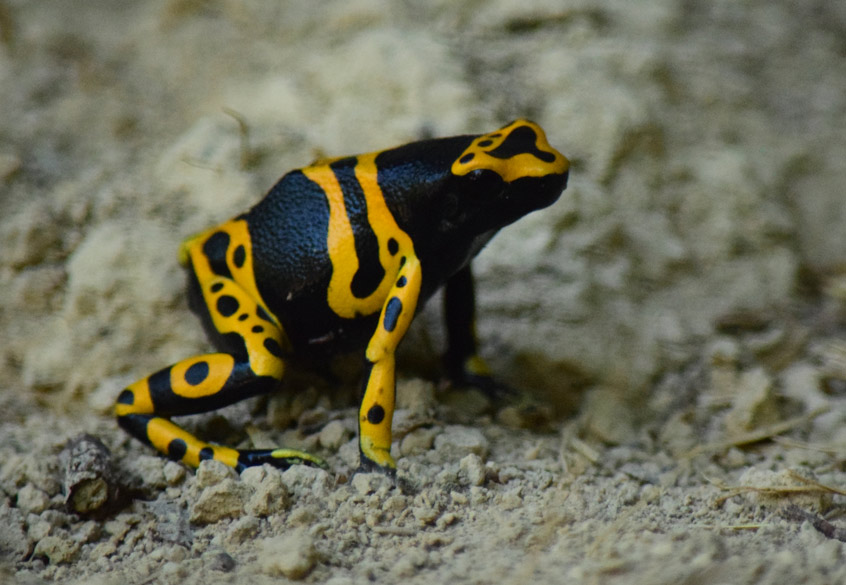
Trapping 101
Later in the day, Lionel and Ian teach us trapping. Lionel has some demo traps set up in the woods already and he explains how to set them up and how to spring them. We all get to set the bow trap and shoot the monkey (a black monkey puppet that is our fake prey animal). Looks fairly complicated, but at least I understand the principle and how to set it up. 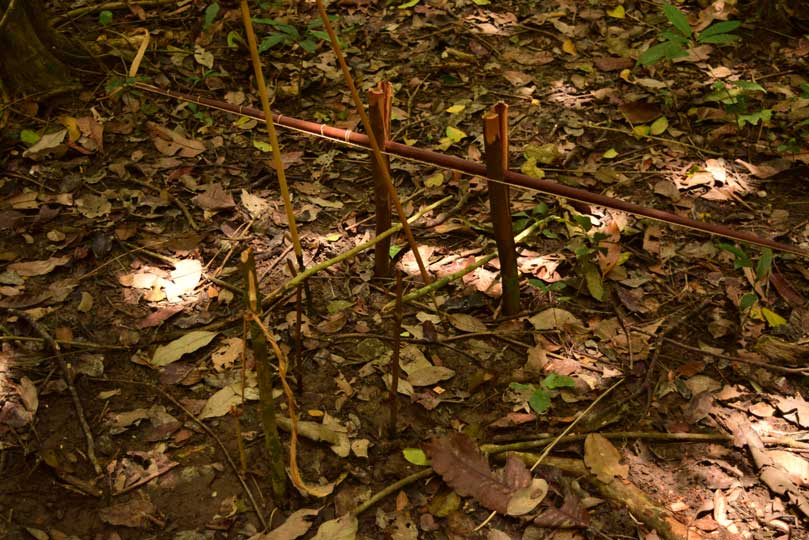
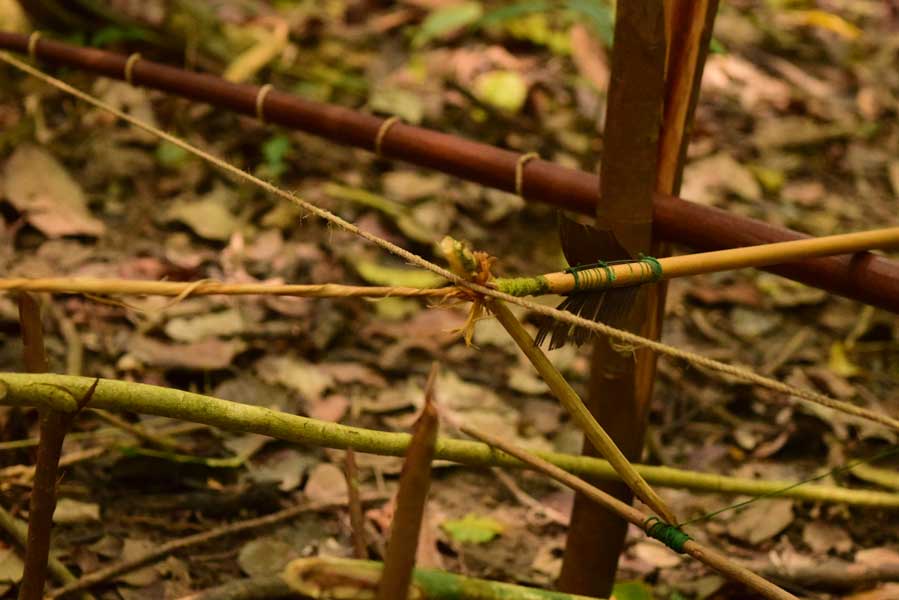 Then we move on to the noose trap: the trap gets triggered, a noose pulls around part of the body of the animal and, with the help of a strong sapling that was bent down and now springs back up, catapults the animal into the air. The key is to get the animal off the ground so it cannot use its powerful legs or claws to get out of the trap.
Then we move on to the noose trap: the trap gets triggered, a noose pulls around part of the body of the animal and, with the help of a strong sapling that was bent down and now springs back up, catapults the animal into the air. The key is to get the animal off the ground so it cannot use its powerful legs or claws to get out of the trap. 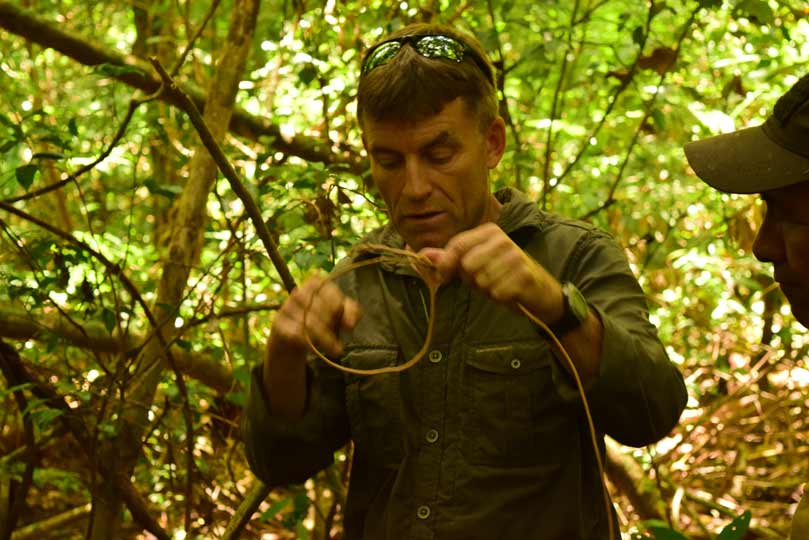
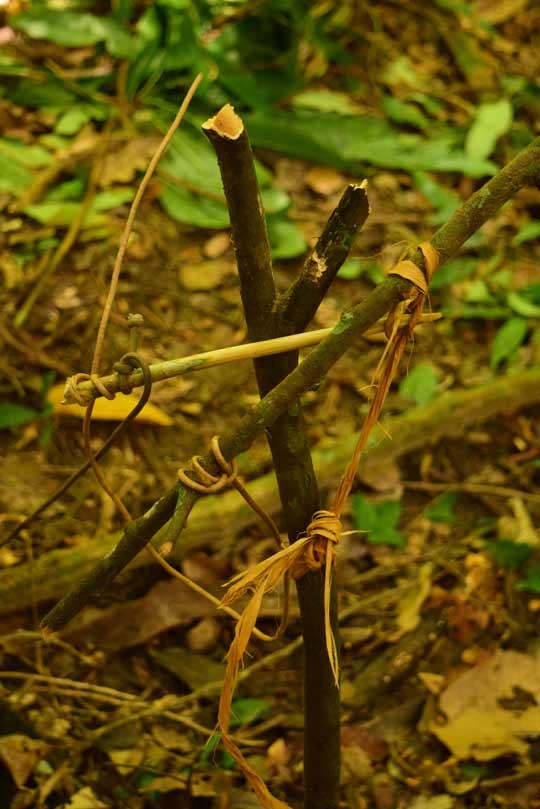 Most of us have more issues with this trap. Seems easier in theory, and maybe more useful, but not that easy to set. Finally, Lionel shows us the spear trap, mostly for animals like peccary: triggering the trap sends a piece of wood to which sharpened pieces of wood or bamboo (like a bunch of short spears) have been tied, crashing into the animal, impaling it in several places at once. This one looks vicious. – The problem with the trapping is that even if we can remember how to set up the traps, we wouldn’t know where.
Most of us have more issues with this trap. Seems easier in theory, and maybe more useful, but not that easy to set. Finally, Lionel shows us the spear trap, mostly for animals like peccary: triggering the trap sends a piece of wood to which sharpened pieces of wood or bamboo (like a bunch of short spears) have been tied, crashing into the animal, impaling it in several places at once. This one looks vicious. – The problem with the trapping is that even if we can remember how to set up the traps, we wouldn’t know where.
None of us are expert animal track readers, we don’t know what animal makes what tracks, how old they are, etc. Even Ian admits that we’re better off fishing than trapping. We get divided into two teams and each need to build two traps. My team does the bow trap and the noose trap. The bow trap is a lot of work to set up, and somehow, we have the angle of the bow wrong, so our arrow shoots too high (we’d get the tapir, but miss the labba). But at least we know what’s wrong and how to fix it.
The noose trap is harder: none of us can remember exactly how to set it up, even though we were shown just a little while ago. We cobble something together, based on whatever we do remember, but it’s not working very well – works three times when we try it, but then fails inspection. The other team rocks the trapping demo! Fishtarians vs carnivores…
It starts raining in the afternoon, while we’re checking each other’s traps. Those of us who have firewood drying in the sun, run to rescue their wood. Then it’s on to bathing and fire making by our bashas.
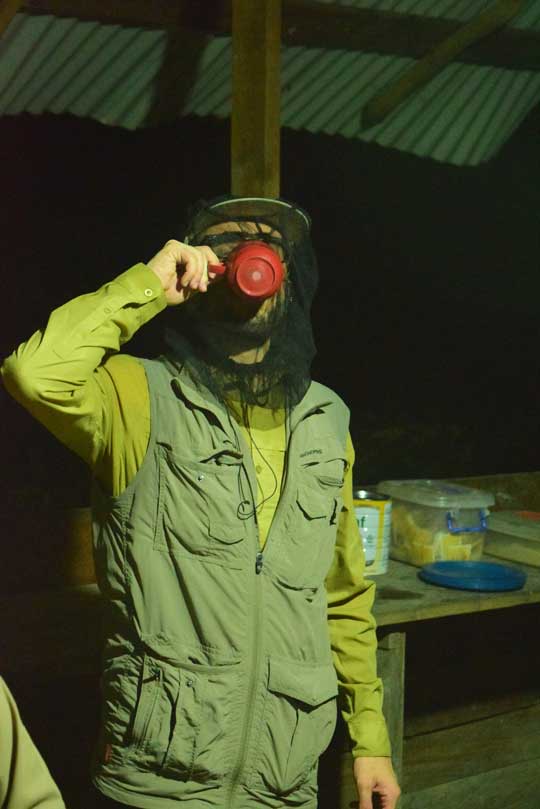
Ian offers to re-supply us with cotton balls, bug spray, etc. Last chance to stock up. Ian says whatever we don’t have in our backpacks (“rucks”) tomorrow isn’t going to the other camp.
The last two people go night fishing with Ian after dinner. They see a tree boa as well, and an injured caiman. But they at least don’t get attacked by the huge wasps that we and the team before us had to fight off: we got dive bombed pretty much the entire time and had to turn our headlamps off at times to get some peace, and kill the wasps that landed in the boat.
Roy got stung on his arm a bunch of times yesterday, in our boat. J isn’t taking any chances tonight: he has head-to-toe protection (yes, he pulled out gloves, too). A smart man is prepared!
The rest of us chat and drink and watch the local wildlife…
Click here to find the full list of posts: My Jungle Adventure
